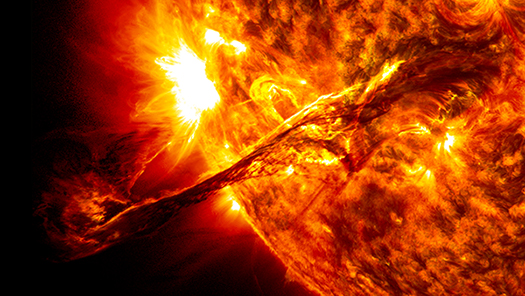Hunting for Stellar CMEs: The Chandra Success
We are pleased to welcome Costanza Argiroffi as a guest author. Costanza led the study reporting the first secure detection of a coronal mass ejection from a star other than the Sun. She is an astrophysicist from the University of Palermo, Italy, where she is from. Her main research field is the study of low-mass stars. She obtained her PhD from the University of Palermo in 2006, and during her studies spent a few months at the Smithsonian Astrophysical Observatory in Cambridge, MA. Then she worked as a postdoc and, since 2008, as a researcher at the University of Palermo.
Coronal Mass Ejections (CMEs) are large-scale expulsions of material previously confined in the atmosphere of a star. CMEs are among the most powerful magnetic phenomena occurring in the atmosphere of the Sun, reaching velocities of about 2 million miles per hour, masses of about 200,000 billion pounds, and kinetic energies equivalent to about 125 million Krakatoa eruptions.
Using data from NASA’s Chandra X-ray Observatory, we have made the first unambiguous detection of a CME by a star other than the Sun.
CMEs, as well as flares, are caused by rearrangements in the magnetic field of a star. These events abruptly release large amounts of energy, and usually a single magnetic rearrangement can provoke both a flare (a closed magnetic structure in the star’s outer atmosphere that becomes suddenly hot and bright) and an associated CME.
Powerful CMEs from the Sun can damage satellites and cause widespread and long-lasting power outages. However, the Sun is not considered to be a magnetically active star. Other stars, especially young ones, can have much stronger magnetic fields, and, as a consequence, magnetic activity levels 10,000 times higher than the solar one. Assuming that active stars have more extreme CMEs (in terms of mass and velocity), then these events should cause enormous amounts of mass to be lost by a star during its life, generating huge amounts of kinetic energy. This should have profound effects on the star’s evolution, and its orbiting planetary systems.
As astronomers have become aware, in the last few years, of the potential impact of powerful stellar CMEs, interest in them has greatly increased. CMEs can be observed on the Sun thanks to the fine details that can be seen in solar images. Searching for stellar CMEs needs different observing techniques, but only a few inconclusive results have been obtained so far.
A coronal mass ejection (CME) of our Sun as observed by NASA's Solar Dynamics Observatory on August 31, 2012.
Thanks to the unrivalled ability of the High Energy Transmission Grating Spectrograph on Chandra to detect details in X-ray spectra, we thought that it could be possible to hunt for stellar CMEs by detecting motions of plasma — hot gas containing charged particles — during strong stellar flares. We did this by searching for shifts in the wavelengths of emission by different elements indicating motion both away and towards us. By performing such a search using Chandra during a stellar flare on the active star HR 9024, we clearly detected and identified a stellar CME. In particular, during the flare we detected upward and downward motions of very hot material (at temperatures of about 10 to 25 million degrees), with velocities of about 225,000 to a 900,000 miles per hour. These motions are due to the material that first moves upward filling the flaring loop, and then settles back down to the atmosphere of the star. Strikingly, we also detected an enduring upward motion after the flare, with velocity of about 200,000 miles per hour, of cooler gas (about 4 million degrees). That is exactly what would be expected for a CME coupled to the flare.
The detected CME has a mass (2 billion billion pounds) that is huge if compared to the most extreme CMEs on the sun, but agrees with the idea that CME properties are proportional to the magnetic activity of a star. Conversely, the CME velocity is 10,000 times less than expected, indicating that the magnetic field of active stars is not efficient as the solar one in accelerating CMEs.
The stellar CME detection presented in this work was possible because of the simultaneous occurrence of several "lucky" aspects: a nearby star + a strong flare + an associated large CME + plasma velocities directed along our line of sight to the star + the "right" instrument pointed to + the right observation duration. Nonetheless, we think that this work suggests a promising technique for systematically searching for stellar CMEs.
Category:
- Log in to post comments


